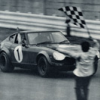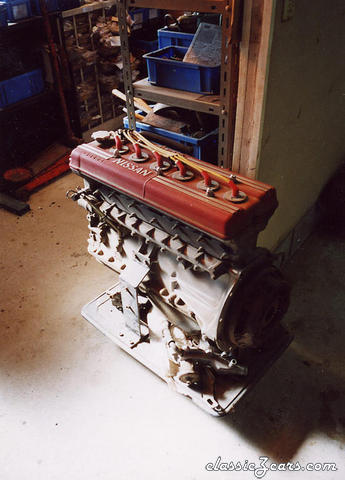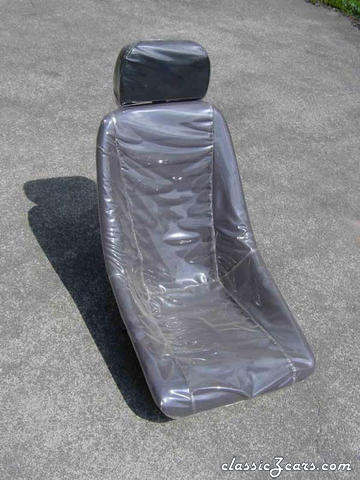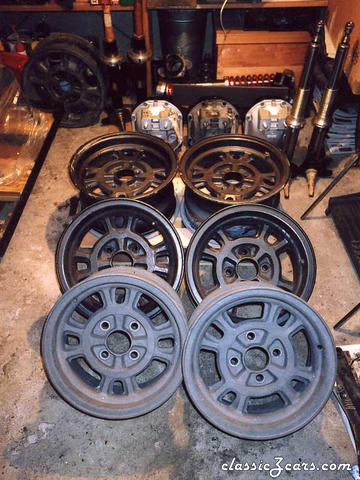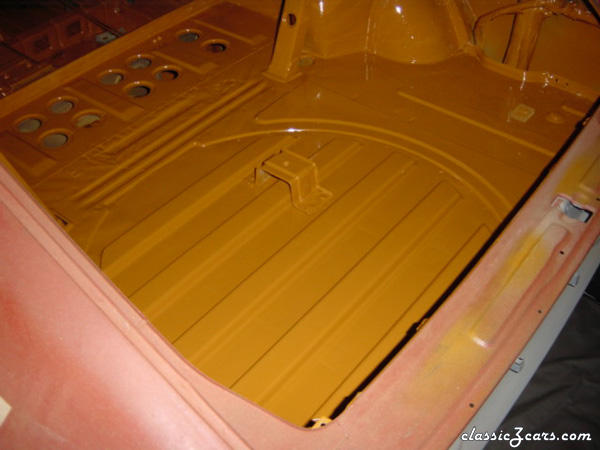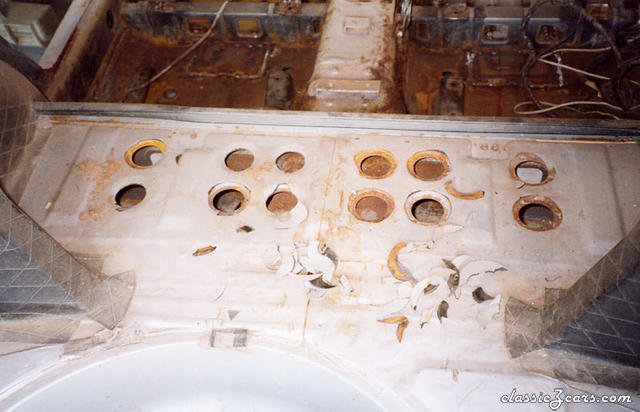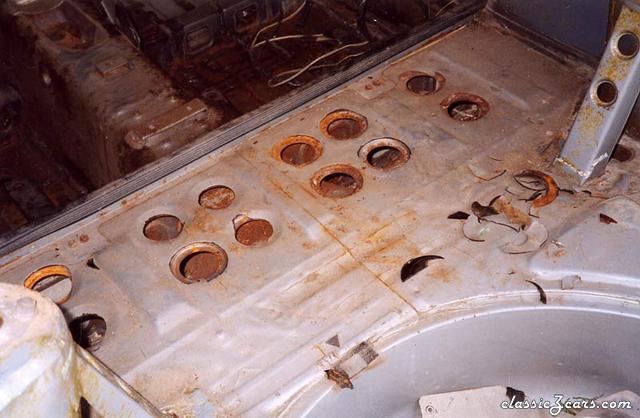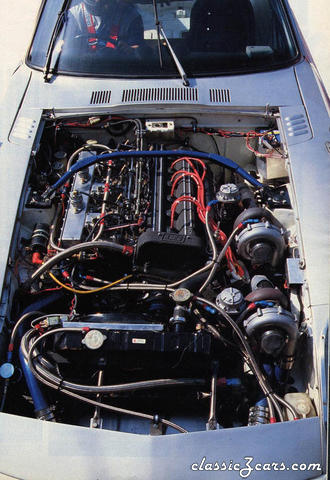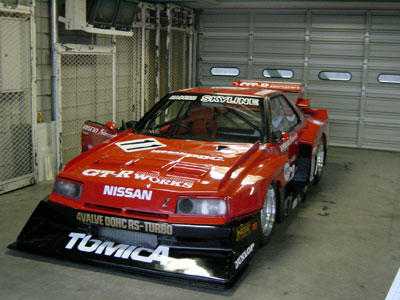Everything posted by HS30-H
-
Is there an E30 head?
No big mystery, The E30 head was fitted to most of the early Japanese-market 2-litre ( L20E ) engined S30's. As Z Kid pointed out, they were also fitted to C10 and C110 series Skylines and a whole host of other Japanese-market-only models. Actually, they are not bad heads at all - but they need a fair bit of modification to make them work well on an engine bigger than the one they were designed to fit on ( nice compression ratio increase though ). I'm not surprised that you didn't find much about them on ZHome.com. Seems to be a bit of a black hole when it comes to the Japanese-market cars ( and there was me thinking that the "Home" of the Z was Japan.................... ). Alan T.
-
S20 Twin Cam engine
I'm teasing myself at the moment too - the bloody engine is still in Japan. I'm having a replica 432 front crossmember made over there( its different to the normal L-series one ). Probably would have been cheaper ( and easier ) to buy a REAL 432 and turn it into a 432R replica.................
-
S20 Twin Cam engine
From the album: Fairlady Z432-R replica project
S20 Twin Cam engine for 432R replica project. -
432R seat
From the album: Fairlady Z432-R replica project
Seat for 432R replica project - still wrapped in plastic.. -
Works Rally Mags
From the album: Fairlady Z432-R replica project
Genuine "Works" Rally Mags for 432R replica project. -
432R rear floor replicated
From the album: Fairlady Z432-R replica project
432R replica rear floor areas after painting. Deletion of spare wheel well makes space for 100 Litre FIA fuel tank. -
Early floor 2
From the album: Fairlady Z432-R replica project
432R replica floor before stripping / blasting. -
Early floor 1
From the album: Fairlady Z432-R replica project
432R replica project floor before stripping. -
Is Removal Necessary
Nigel, When I started pulling up that rear floor insulation on my 1970 project car I was horrified to find that it revealed quite a lot of surface rust..................... To be honest, the insulation was a bit scruffy - but I had NO IDEA that it was going rusty underneath. The idea of stripping it all out was part of my "432R Replica" theme ( they had no insulation in them whatsoever ) so I was trying to replicate that. What with the 1970 body being "pre-storage bin" ( just stamped holes in the floor ) there was actually quite a lot more of the insulation than on the later cars. This has now all been stripped off, blasted and painted. Makes me feel double satisfied to think that I have removed some really sneaky hiding rust and replicated the 432R at the same time. I should put some before and after photos up in the Member Galleries. Yours might not be as rusty as mine was, though.......... Alan T.
-
TC24-B1 with twin turbos
Twin turbo conversion of O.S. Giken TC24-B1 twin-cam crossflow head on 3 litre L-series ( 1986 photo ).
-
Gasket set for an L20?
Bleachzee, Please be careful not to mis-describe your engine when ordering gaskets. You mentioned "L20b" above - which is a four-cylinder engine................ Gaskets and ALL parts for the L20 are still available from Nissan Japan, and there are hundreds of thousands of cars running around in Japan which are still using the L20 six. Just make sure that your parts supplier orders the parts for the right engine. Block height is the same as the twin-carbed L24 / L26 / L28 engines - so all gaskets other than the head gasket will interchange. Good luck, Alan T.
-
spirit garage s30Z racecar
www.bestmotoring.jp = Main Japanese page. www.bestmotoringvideo.com = Main English language page. The Japanese pages have more downloads and are more up to date than the English language pages, as it takes them a little while to dub / edit the new titles with English. Alan T.
-
spirit garage s30Z racecar
trs, thanks for understanding what I am trying to get across. I completely understand your enthusiasm for this kind of thing ( which I share ), and like you I would like more people to see and understand what's going on in Japan S30-wise and with old cars in general. I think you and I are probably both on the same side as far as that goes. I worked with 2 & 4 on several occasions, but all of them were in connection with the Japanese car magazine that I work for on a freelance basis ( ENGINE Magazine ). They were tie-ups with the Japanese Lotus importers, and in particular we worked on the Lotus one-make race series here in the UK ( now defunct ) that used the Motorsport Elise ( the road version of which was called the Exige ). We worked with Keiichi Tsuchiya three times, and once with Naoki Hattori ( who some people may remember as an ex-Champ Car driver ). Tsuchiya was great fun to work with, and impressed everybody at Lotus with a really good time at the Lotus test track at Hethel. He always had bad luck in the races, and had to make do with a bit of a dog of a race car that was made up from a crashed chassis. Hattori matched him when they raced at Oulton Park, and I can say that both of them are very impressive drivers who make a lot of very intersting observations about the cars they test on the videos. I'm sorry to say that I can't remember which videos these exploits ended up on ( I think one of the races was in the BM Special Vol.46, and at least one other report was on a Lotus special video ). 2 & 4 always excel at their in-car cameras and split-screen displays, and the cars always have to carry a lot of equipment. I was always hugely impressed with how quickly they installed all of this in the car and got it to work so well. The end product is absolutely fascinating. Their Video Special Vol.56 is a tie-in with the release of the Z33, and features some interesting cars from the whole Z range. The "Caster" is Mr Haruto Yanagida ( boss of "Central 20", and one of the S30-series Z car's most successful Privateer and Works race car drivers ) along with his son, who has been testing the Z33 race car in Japan. As far as 260Z's idea to show a clip / promo on this site - I think it would surely be a lot of work to get this ironed out. They have their own website, and surely if this site were to have any promotion for them it would mean money changing hands? I can't see 2 & 4 doing this unless they do it for a lot of other makes first ( such a small amount of their product is Z-related ). I could always ask them, but I think I can imagine what the answer might be. I honestly think only a very few of the people who look at this site will be interested enough to order one of these videos or DVDs, and if they ARE eager enough then they would surely be looking at the Best Motoring site already?................ And 260Z, I should imagine that I have partaken in "piracy" of one form or another in the past, as most of us probably have. However, as I said in my original post, this company's products feel very close to home for me. Maybe that's why I feel so strongly about it in this case. Alan T.
-
spirit garage s30Z racecar
Mike, Can I point something out here? I don't want to be a killjoy, but this talk of putting some of the video up on this site rather shocked me. Please stop and have a think about it for moment. I remember some months back you were concerned that somebody seemed to be copying and selling the microfiche CD that you had made and marketed. There was a big debate about piracy and how to stop it from happening. So what's changed? If you put this file up on the web and allow everyone to have access to it, then I see no real difference apart from the fact that no money is changing hands. I have to declare an interest that makes this particular case all the more important to me; I have worked with "2 & 4 Motoring Co. Ltd." ( the makers of the Best Motoring / Hot Version videos, who are owned by the Kodansha publishing group ) in Japan and here in the UK, and I am quite friendly with Tohru Yamamoto - essentially the boss of the company. Being this close to them makes me feel potentially all the more guilty at the thought of you putting anything that they have created up on the site for all to see. At the end of each of the Video / DVD realeases from this company, there is a piracy warning ( just like anywhere else ). For the Japanese-market releases its written in Japanese, but in the Export market versions ( only a select few titles at this time ) it is of course written in English. Just because its Japanese does not make it fair game to copy / pirate / distribute. 2 & 4 make these videos as a business. It costs them a lot of money to make them ( if anyone sees one of them they might realise how much goes into it ) and only the fact that they can sell and distribute them carefully allows them to make more. We are not talking about a huge company here, like Sony or EMI - where Napster and similar ideas were seen as Robin Hoods robbing the rich and giving to the poor. 2 & 4 has a core staff of less than 20 people, and they market their product mainly through their website. The new releases usually make it into Japanese bookshops ( in the motoring section ) but the core of their business is through mail order. What I am trying to say is that they are not a multi-million dollar outfit that can afford to take a hit from a little bit of piracy. Sorry to sound so dramatic, but this strikes very close to home for me. I have earned money from working with 2 & 4 on three of the Best Motoring titles, and it feels to me as though I have to defend them. Most of us at some time have copied a video / CD / Software / magazine article / picture for a friend or acquaintance - or been in receipt of something that has been copied ( I am no different ). I guess that this is in fact technically illegal, as almost all products / publications have to guard against it ( even this site? ). It will, however, always go on. The main thing is that we should all try to be conscious about what we are doing and try to be sensible about it. Copying for a friend to see is quite different from sticking something up on the web for the whole world to download..................... One could argue that a clip on this site would be "free publicity" or some kind of promotion for the company that makes it - but I think we can agree that it would more likely lead to a wildfire duplication of the file and free distribution around the globe. I doubt that this would lead to more business for them, unless they try to make more English-language versions. I have given the link to the Best Motoring website here before: www.bestmotoring.jp - and it is possible for people to make International orders with them. I believe that they even have a USA distributor. They have downloadable clips on their site, and I think all in all the videos and DVDs that they sell are very good value for money. The point is that I don't think that they are so enormously expensive / overpriced that they would "deserve" to be pirated. Like I say, I don't want to be a killjoy ( hell - I would LOVE people to see what good cars / parts are around in Japan, and I have bought a fair bit of stuff from SPIRIT GARAGE myself ) but this case strikes rather close to home for me. I have very mixed sentiments, as like "trs" I would love to spread the word about the Japanese Z scene and cars like this. I can't stop you trying to put the clip up on the site, but I'd prefer you to stop and think about what you are doing. Just because its a Japanese product does not make it fair game for us to do what we want with it. Hope that you will understand my sentiments. Faithfully, Alan T.
-
Vintage Mustang owner on a Vintage Z site
Hi Eric, I used to own a '65 Mustang many years ago, and my main memory of it is that the suspension squeaked a lot. Didn't matter what I did, we couldn't stop it squeaking. Since I bought an early Z,its now me that squeaks. R.S.WATANABE wheels are still made by R.S.Watanabe in Japan, and I would presume that you are interested in their classic 8 spoke design ( which have always been known as the "Hachi Spo" in Japan ). Watanabe still make the classic deep-dish version in both Aluminium and ( very expensive ) Magnesium. They also added a split-rim version some years ago. They have many other designs of wheel available too. Check out their website at: www.rs-watanabe.co.jp Its mostly in Japanese and can be quite hard to navigate and see what you want - but I can assure you that its all in there somewhere. They have some data for the S30-series Z car with recommended fitment sizes. The 15 inch rim diameter is more useful these days as its much easier to find suitable tyres for them. If buying used R.S.Watanabe 8-spokes, be careful that you do not end up with a set that was designed for a later model ( wrong offsets ) or a FWD type ( very wrong offsets ). Watanabe have made these wheels for many years and for a great many applications. Be careful. The early Seventies castings ( and Magnesium forgings ) are becoming quite collectable in Japan now. Most early ones had a manufacturing date on the back. Good luck ( hope you get a Z ), Alan T.
-
Yikes!!! Look what's for sale here
The original IMSA cars looked great, but this attempt is quite far away from looking like one of them. I was particularly amazed by the efforts to make the nose look something like a Ferrari GTO ( notice the low oval air intake and the three scoops above it ). I wonder if that was part of the original "kit" or a further modification by the original owner. The wiring looks very professional ( not ). Love that Nitrous bottle ( not plumbed in of course ). Zedrally and 240Z what are you both thinking of!!?? Have you been looking at the HybridZ site too much lately? Alan T.
-
Yikes!!! Look what's for sale here
It's a new George Barris design for the 2003 PopeMobile.
-
Yikes!!! Look what's for sale here
Too late DRECORD, I already saw it. I've already got the intravenous drip attached and I'm waiting for the Ambulance as I write this.................. Alan T. ( I lost my heart to a Starship Trooper ).
-
RB conversion parts 4 sale
Cuong is travelling in the Far East at the moment, so don't be surprised if he doesn't answer this for a few weeks yet. All the best, Alan T.
-
Exact Import Numbers for Australia
Hi Gavin, Thats a relatively low chassis number that you have there. The actual date of manufacture was not "officially" marked on most of the early RHD models as far as I am aware. However, I wonder of the Australian market cars had a similar tag on the inside of the door jamb ( just by the catch ) to the LHD cars, which stated a manufacturing date for local compliance purposes? The UK and Japanese home-market cars certainly did not. I can't remember whether they did or not - but if you DO find one please bear in mind that the RHD cars had to stick around in Japan for a lot longer than the LHD cars, while they got enough made / ordered for a consignment to be sent out. Some of my Japanese friends have told me that they remembered RHD Z cars sitting at the dockside in Yokohama for weeks and even months before being sent out. Compare this to the USA / North American market cars which were being sent out just as fast as they could put them together. Add this up, and it means that quite a lot of early RHD cars ended up at their destinations quite a long time ( relatively speaking ) after leaving the assembly line. For this reason, the local compliance / date of manufacture tag ( if fitted ) would not necessarily all that accurate on an RHD car compared to an LHD car. Based on the manufacture date of other cars that I know, I would think your car is indeed a mid to late 1971 manufactured car. To pin this down more accurately, you might want to get into Sherlock Holmes mode and start sniffing around your car for clues. First place to look would be the cloth tags on the seatbelts ( presuming the original Takata Kojyo belts are still in it ). These state the month and year of manufacture, and can provide a good clue. Usually they were made only a few weeks before the car was put together. Other places to look are on things like the back of the ashtray, the fusebox, back lamp housings and other items like that. You will quite often, but not always, see a round-shaped ink-stamp with a series of numbers in it. This is usually the manufacturing date of that item - but its in Japanese year date system according to the incumbent Emperor's reign ( in the case of your Z - it was still Emperor Hirohito, who the Japanese know as Emperor "Showa" ). To get the "correct" year date, just add 25 to the last two numbers on the date stamp. This is because the "Showa" era started in 1925. You will be therefore probably be looking at date-stamp numbers that end in 46 ( meaning 1971 ). If you see more than one 45 number, your car could well be an earlyish 1971 car. However, from your VIN number I think its a later 1971 car ( arguably one of the better dates to have in an RHD car ). You can also date these cars from the glass manufacturing marks and other more obscure places - but that's too complicated to get into here. Have a dig around your car and see what you can come up with datewise. If you need any help I would be glad to try to assist. I love early RHD cars in particular. Glad you are not too upset by the fact that its not some kind of Homologation Special. All too often people mis-identify stuff because they do not have much data on it. I guess this is what happened with the person who described your car as something other than a "normal" early RHD car. What you actually have is something rather good anyway. Remember that the early RHD cars were a much better spec. than the LHD cars ( 5-speed, 3.9 diff, rear anti-roll bar and the driver sitting in the "right" place! ). Hope that you take it back to its original colour, and close to original spec. if its been modified in any way. These relatively early HS30's are worth looking after. All the best, Alan T.
-
Exact Import Numbers for Australia
Sorry Gavin, but that "World Rally Spec." thing is just not true. ALL of the early "HS30" VIN prefixed cars ( that's RHD L24-engined cars ) had the 5-speed "A" type transmission - which had fairly close ratios anyway. The ratios changed to a more widely-spaced set when the "B" type 5-speed was phased in, so this is why you tend to hear about the "Close Ratio" gearbox thing. I quite often see comments from USA owners about "special racing transmissions" or similar when they are merely describing either an early "A" type 5-speed or one of the Sports Option transmissions available from Nissan Motorsports in the USA from the early 1970's ( which, apart from the proper "Dogleg" shift-pattern competition boxes, are usually just the 5-speeds that were stock in other markets except the USA ). The E31 head was also stock on most early cars ( what's your VIN number? ). Please don't believe any of that "special run" talk, as the only way that it can be seen as true is in the fact that there really were not all that many early "HS30" cars IN COMPARISON to the amount of early "HLS30" models that the Factory knocked out........ There was no real "Special Model" for Australia; you have to count the "HS30" VIN prefixed cars that went to Australia as very similar to most other "HS30" VIN prefixed cars, although they were arguably more similar to the Japanese market "HS30" prefixed cars than they were to the other ( mainly UK market ) "HS30". This was mainly due to the retention of the proper wraparound front indicators at the front where the UK version had compliance problems with them and switched to a rather ugly version on top of the front bumper. Take those figures from z.home as "gospel" at your peril; they purport to indicate production figures that relate to RHD cars for export. They do not seem to include any of the Japanese home-market cars ( very important ) and they come from the notoriously inaccurate "Datsun 280ZX" book that NMC published when the ZX was launched. They certainly will not help you in relation to how many cars made it to Australia. I would guess that "accurate" figures for Australian-market "HS30" VIN prefix cars would have to come from sources within Australia ( who must be privy to more and better info than that available elsewhere ). This must be known by the Z clubs in Australia surely? Be careful of conjecture though. A nice 1971 HS30 is a good thing to have. Are you sure that it really WAS made in 1971 ( and not 1970 ) - as I would have thought the E31 head makes it statistically more likely to be a 1970 manufactured car. This would be even better ( especially for those early VIN number lovers ). Like I said - what's the VIN number? Maybe this will help to identify it properly. Good luck with it, Alan T.
-
Gr.5 SKYLINE
Hi Ben, Sure, I've got this one in a pretty high-res. version too. I will mail it to you direct. This is one of the cars that features in the Skyline Racing video that I'm sending to you - so you have a good bite of flame-spitting and tyre-spinning video image to look forward to. At least in the video its in the dry ( but at tight Tsukuba track ) which it was not at the 2002 Nismo Festival ( very hard to control ). By the way, did you know that the Japanese nickname for the Gr.5 Skyline Silhouette racer was "Deppa"? Its a good one to remember if talking to any Japanese R30 fans. Basically it relates to the habit of spitting metre-long flames out of the side exhaust on the over-run. All the best, Alan T.
-
240z colour combinations
Hi Lee and George, I can tell you that different markets got slightly different colour choices and combos. For the most part they were the same, but there were differences that throw everything out of the window. Most of the data that you will find refers to the USA / North American market cars ( not the same as other markets ). I can tell you that ( like George's car ) there were a lot of Green cars with Black interiors in the Japanese market - so you can bet a lot of the other RHD market cars were in a similar position. All the best, Alan T.
-
Production date question
Hi Rolf, Happy New Year. Actually, most of the RHD market cars did NOT have the little tag on the door jamb that quotes a manufacturing date.................... Like I said, its a lot easier to track the true age / manufacturing date of a LHD market car than an RHD market car............ I have to say that I think this concept of "Model Year" is confusing, and is linked more to marketing / sales than to any reality of manufacturing date. I have never heard the Japanese talk about a "Model Year" ( EG "1971 model" for a late 1970-made Z ) and to my mind it can only be a local market idea that is propogated in order to help sales. As far as I know ( and I could well be mistaken ) there was never any such idea as this at Nissan Japan in the early 1970's period. I also have a very strong suspicion that a lot of the dates on those door jamb plates were "tweaked" to suit business needs in Japan........................ Not that Nissan would ever admit it. Alan T.
-
How do you like the front of your Z?
Right ionman, I see where you are coming from. Amen to what you say. Mind you, I can see the attraction for people to try to make their cars ( not just Z cars ) something more ( to their way of thinking ) than they already are. I guess that's human nature. Any of the modifications / additions / deletions that I make to my Z cars conform to a sort of self-imposed set of rules that I have made for myself. One of these rules is to try to keep everything "period" correct for the early Seventies period. Hence the 14 inch wheels ( which make it a pain to find good tyres that are not too "modern" in profile ). I also try ( sometimes with more success than others ) to find parts that were available as Nissan "SPORTS OPTION" items in Japan during the period when the cars were current. As far as I am concerned, this makes them legitimate and "correct" to use. Like I say, its a self-imposed set of rules that I just have in my head. Your car looks super clean and original. These days that makes it unusual. Thats sure to give you even more satisfaction, and I can relate to your way of thinking. Best regards, Alan T.




